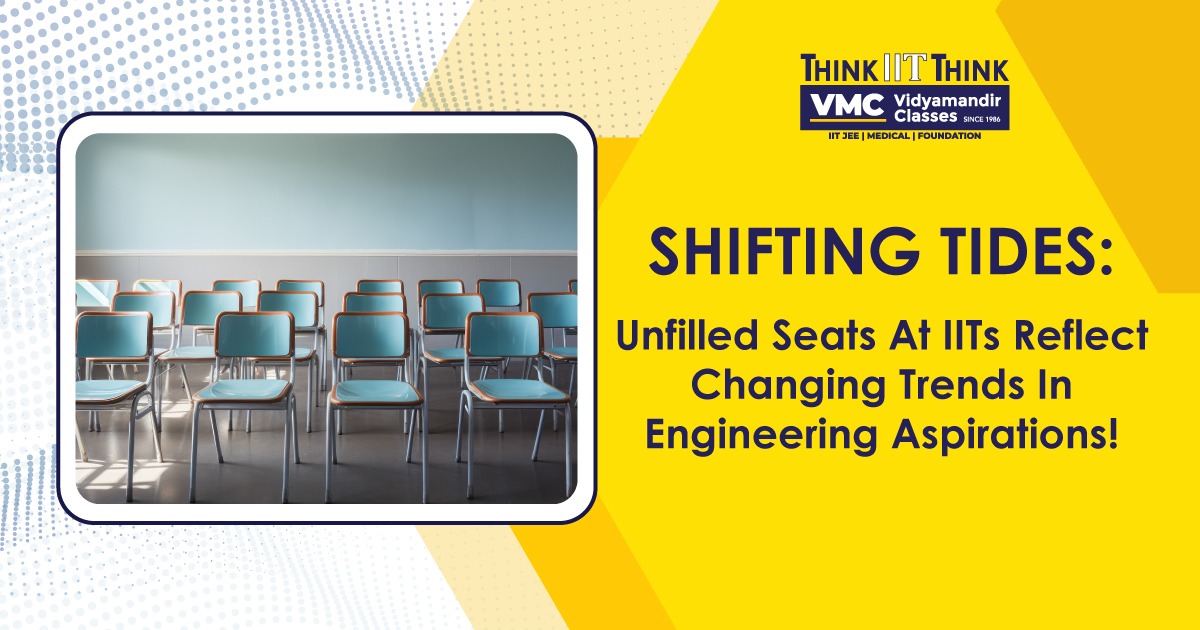Shifting Tides: Unfilled Seats at IITs Reflect Changing Trends in Engineering Aspirations!
 Posted On
Posted On
284 total views, 2 views today
In the ever-competitive landscape of engineering education in India, securing a seat in the prestigious Indian Institutes of Technology (IITs) is the dream of countless students. The Joint Entrance Examination (JEE) serves as the gateway to these coveted institutions, with aspirants dedicating tireless efforts to crack the challenging exam. However, an unusual development has taken place this year, as, for the first time in five years, a handful of undergraduate seats in IITs remain vacant even after six rounds of counselling conducted by the Joint Seat Allocation Authority (JoSAA).
The Numbers:
Out of a total of 17,385 seats spread across 23 IITs, an impressive 17,340 have found takers, including 3,422 female candidates. Despite this remarkable accomplishment, a lingering 45 seats remain unclaimed, marking an unprecedented occurrence in recent history.
Historical Perspective:
Over the past five years, data reveals that the number of allocated seats at the conclusion of JoSAA has consistently surpassed the initially available seats. Last year, with 16,598 seats initially on the table, the allocated seats reached 16,635. Similarly, in 2022, the initial count was 16,232, but after the sixth round of counselling, the allocated seats increased to 16,296.
Chairman’s Insight:
Professor Biswupad Mandal, the Chairman of JEE Advanced 2023, sheds light on this phenomenon. He explains that the creation of additional seats is a customary practice, often arising from tie situations for certain seats, which attracts more applications. These supernumerary seats contribute to the displayed allocation in IITs exceeding the originally available seats.
Changing Trends and Non-IIT Options:
However, the subtle shift in this year’s dynamics suggests that post-pandemic, non-IIT options are gaining traction among engineering aspirants. The difference between available and allocated seats implies that some IIT branches might still have vacancies. Students, now armed with more alternatives, might be opting for non-IIT institutes, showcasing a nuanced shift in preferences.
Factors Influencing Choices:
Several factors contribute to this evolving trend. Students, cognizant of the fierce competition, may choose not to participate in JoSAA counselling if they anticipate challenges in securing admission to their preferred course or IIT. Instead, they are exploring alternative avenues in non-IIT institutions, reflecting a pragmatic approach to their academic pursuits.
Exploring the Shift:
Let’s delve into the various facets of this changing landscape and understand the factors that might be influencing students to look beyond the traditional allure of IITs.
Broader Horizons:
The allure of IITs has long been ingrained in the psyche of engineering aspirants. However, the current scenario suggests a paradigm shift, with students increasingly recognizing the value and quality of education offered by non-IIT institutions. This broader perspective allows students to explore diverse opportunities beyond the IIT spectrum.
Specialized Programs:
While IITs are renowned for their comprehensive engineering programs, non-IIT institutions have been stepping up to offer specialized courses that align with the evolving needs of industries. This targeted approach appeals to students who are keen on gaining expertise in specific domains rather than opting for a more generalized curriculum.
Campus Placements:
The job market is dynamic, and students are becoming more discerning when it comes to choosing an institution that not only imparts quality education but also facilitates robust placement opportunities. Non-IIT institutions are increasingly investing in building strong industry connections and ensuring favorable placement outcomes for their graduates.
Geographical Preferences:
The location of an institution plays a crucial role in students’ decision-making processes. Non-IIT institutes, situated in different parts of the country, may be aligning with the geographical preferences of students. This becomes particularly relevant as students consider factors such as climate, culture, and proximity to home.
Adaptability to New Norms:
The COVID-19 pandemic has ushered in a new era of online education and remote work. Students are now more open to exploring institutions that have effectively adapted to these changes, offering hybrid learning models and flexible options. Non-IIT institutions, quick to adapt, might be gaining favor among students seeking a modern and adaptive learning environment.
Final Thoughts:
The phenomenon of unfilled seats in IITs after six rounds of counselling serves as a reflection of the evolving landscape of engineering education in India. While the allure of IITs remains potent, students are now exploring a wider spectrum of options, considering factors such as specialized programs, campus placements, geographical preferences, and adaptability to new norms.
This shift does not diminish the significance of IITs but rather underscores the diversification of aspirations among engineering aspirants. As the educational ecosystem continues to evolve, institutions, both IITs and non-IITs alike, will need to adapt and innovate to meet the changing needs and preferences of the students who shape the future of engineering in India.




